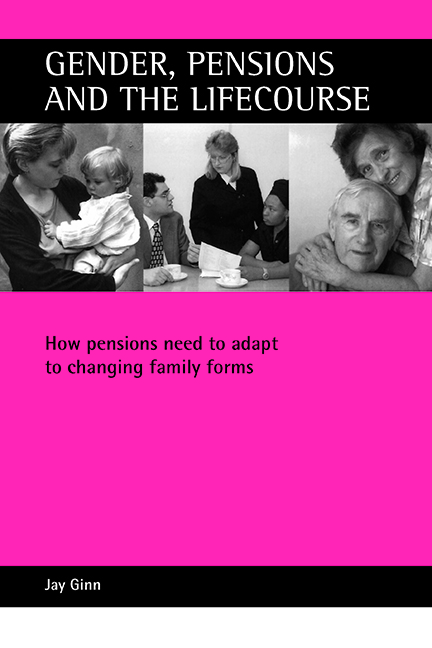Book contents
- Frontmatter
- Contents
- List of tables and figures
- Acknowledgements
- one Trends in gender relations, employment and pensions
- two Choice and risk in pensions: gender and class inequalities
- three Pension prospects for minority ethnic groups
- four Changing patterns of partnership: divorce and pensions
- five Impact of motherhood on pension acquisition: differentiation according to education
- six Gender and pensions in the European Union: towards an independence model?
- seven British pension policy: a gender perspective on alternative rescue plans
- References
- Appendix Statistical tables
- Index
four - Changing patterns of partnership: divorce and pensions
Published online by Cambridge University Press: 20 January 2022
- Frontmatter
- Contents
- List of tables and figures
- Acknowledgements
- one Trends in gender relations, employment and pensions
- two Choice and risk in pensions: gender and class inequalities
- three Pension prospects for minority ethnic groups
- four Changing patterns of partnership: divorce and pensions
- five Impact of motherhood on pension acquisition: differentiation according to education
- six Gender and pensions in the European Union: towards an independence model?
- seven British pension policy: a gender perspective on alternative rescue plans
- References
- Appendix Statistical tables
- Index
Summary
Since the 1960s, a more permissive social and legal climate concerning sexual relationships and family forms has led to parallel demographic trends in many western countries. These include rising cohabitation, postponement of marriage, increased divorce rates and extramarital births, increased use of family planning and low fertility rates – a set of changes that has been termed the second demographic transition.
The far-reaching changes in partnership status and parenting create new challenges for a pension system originally based on the male breadwinner– female homemaker model. Public pensions established means of providing pensions for married women and widows (Daly, 1996; Sainsbury, 1996; see also Chapter One), while occupational pensions have also generally provided widows’ pensions. At a time when the link between marriage and motherhood was close, such derived rights based on a husband’s contribution record ensured that most mothers received some pension compensation for their unpaid childrearing role, as well as for providing domestic services to their family more generally. Yet the separation of the roles of wife and mother, as the link between marriage and childrearing loosens, raises questions for pension schemes – both state and private.
Changing family forms and gender roles are often neglected in analysis of pension policy, where the predominant focus has been state and market, as noted by O’Connor et al (1999).
In this chapter, I first consider issues of equity arising from the growing mismatch between family forms and the acquisition of pension rights through marriage, then review the divergence of marriage and motherhood and the gap in childcare provision in Britain. The chapter then considers how partnership status affects employment and pension acquisition, drawing on research using data from three years of the British General Household Survey (Ginn and Price, 2002) and focusing on the pension prospects of divorced and separated women.
Derived pensions: issues of equity
The generation of women born before 1940 grew up with a pension system based on the male breadwinner–female homemaker model, as outlined in Chapter One. The Beveridge structure of National Insurance discouraged married women from building independent state and private pension entitlements through employment and pension contributions, thus rewarding and reinforcing the male breadwinner model (Allatt, 1981; Baldwin and Falkingham, 1994).
- Type
- Chapter
- Information
- Gender, Pensions and the LifecourseHow Pensions Need to Adapt to Changing Family Forms, pp. 51 - 68Publisher: Bristol University PressPrint publication year: 2003



